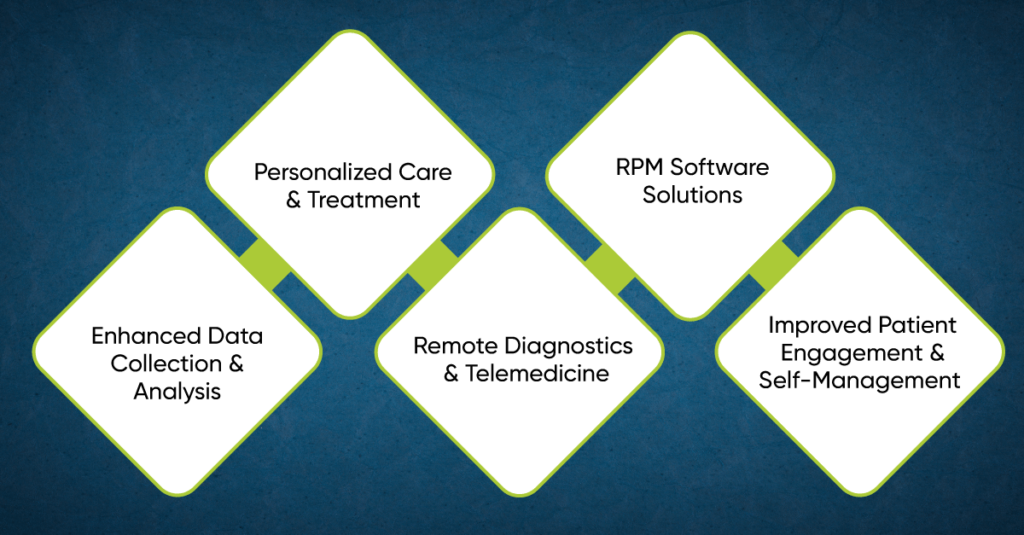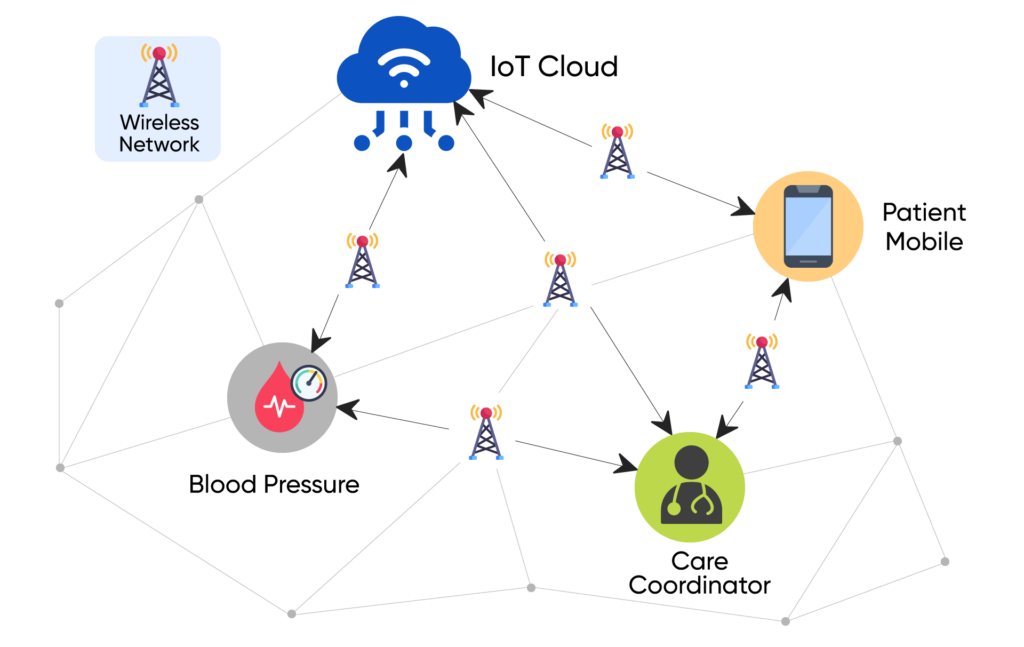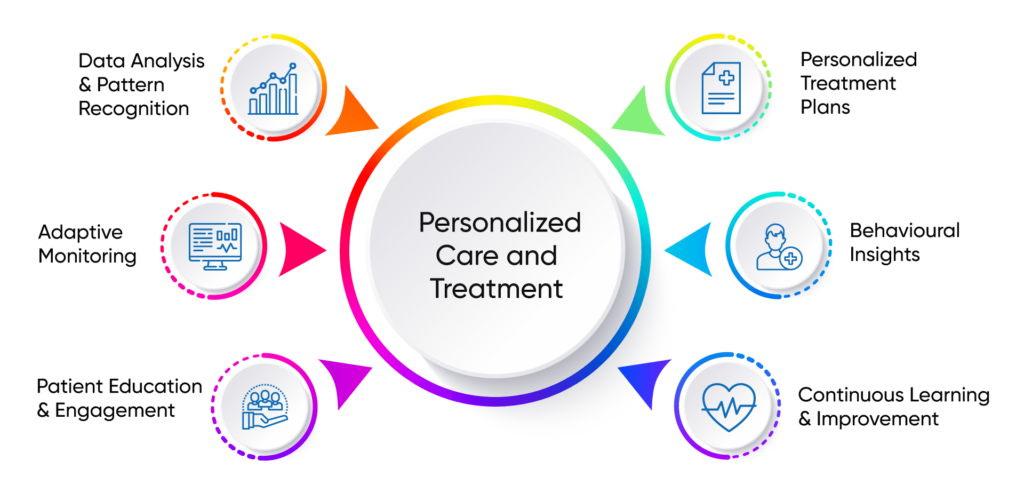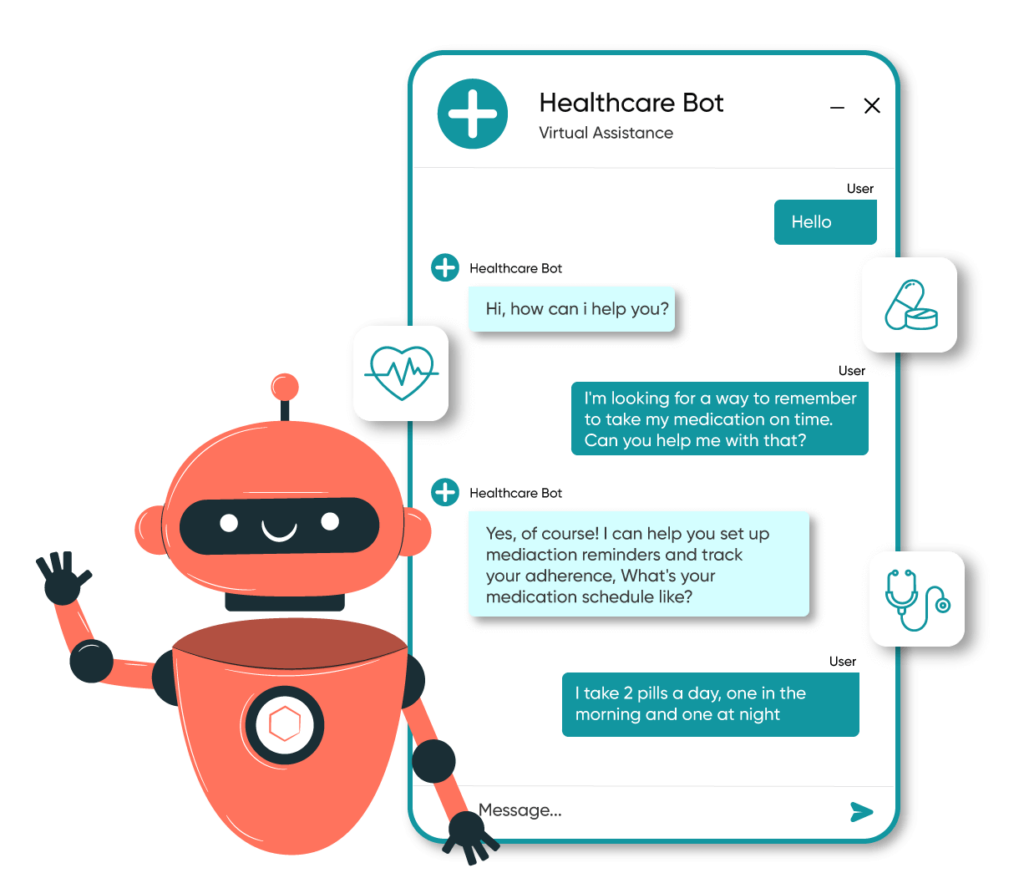Five Ways AI is Transforming Remote Patient Monitoring
AI technologies, such as machine learning and computer vision, help healthcare professionals with various tasks in the medical field. Artificial intelligence (AI) has undoubtedly transformed healthcare by providing more accurate and efficient diagnoses, individualized treatment regimens, and predictive analytics.
AI-based health monitoring systems can analyze various types of medical data, such as health records and images. This analysis then helps to identify patterns and trends that can assist in detecting illnesses at an early stage. Ultimately, this improves patient outcomes.
Furthermore, artificial intelligence-powered virtual assistants and chatbots improve patient involvement and assistance, while robotics improve surgical precision and patient care. Despite its apparent benefits, AI in healthcare needs ethical, privacy, and security considerations to ensure safe and responsible use.

1. Enhanced Data Collection and Analysis
In healthcare, improved data collection involves utilizing technology such as wearable devices, remote patient monitoring systems, and electronic health records. These technologies gather patient information, including vital signs, symptoms, medication adherence, and lifestyle behaviors. This continuous and real-time data gathering later enables healthcare practitioners to monitor patients’ health more effectively.
Better data analysis involves using advanced algorithms and machine learning to quickly and effectively analyze large amounts of data. This sophisticated analysis aids in identifying patterns, trends, correlations, and anomalies in data that might otherwise be missed using standard approaches.
There are various advantages to improved data collecting and analysis in healthcare. It is vital to consider data privacy, security, and ethical issues when gathering and studying data in healthcare. This is to protect patient privacy and trust in the healthcare system. Furthermore, it allows evidence-based decision-making, healthcare process optimization, and identifying opportunities for improvement in patient care.
However, to retain patient privacy and confidence in the healthcare system, it is critical to address data privacy, security, and ethical concerns while collecting and analyzing data. So healthcare workers need to understand and use data to improve patient outcomes, considering the context and their clinical knowledge.

2. Personalized Care and Treatment
AI is crucial in Remote Patient Monitoring (RPM). AI-based health monitoring system utilizes patient data and advanced algorithms. Later this helps in tailoring healthcare interventions for each patient individually.
Here’s how AI contributes to personalized care and treatment in RPM:

Data Analysis and Pattern Recognition:
AI health monitoring algorithms can analyze lots of patient data from RPM devices, for example, vital signs, symptoms, and lifestyle info.
Personalized Treatment Plans:
AI health monitoring can assist in developing individualized treatment plans based on a patient’s unique health profile. These alerts then prompt healthcare providers to take immediate action, preventing adverse events or worsening conditions.
Adaptive Monitoring:
AI-driven RPM systems can simultaneously adapt their monitoring frequency and parameters based on patient progress or changes in health status.
Behavioral Insights:
AI patient monitoring can analyze patient behavior using data from RPM devices. This includes activities such as taking medication or being active. The goal is to understand their habits and lifestyle choices.
Patient Education and Engagement:
AI-powered remote patient monitoring uses technology to provide personalized educational content and health recommendations to patients. Later, by customizing the information to each patient’s needs and preferences, AI helps patients stay engaged and follow their treatment plans.
Continuous Learning and Improvement:
AI patient monitoring systems can continually learn from new data, including patient outcomes and treatment responses. Using AI, RPM helps healthcare providers give personalized care and treatment, improving patient outcomes and healthcare efficiency. Moreover, it actively empowers patients to participate in their healthcare journey and fosters a more patient-centered approach to medicine.
3. Remote Diagnostics and Telemedicine
AI is essential for improving Remote Diagnostics and Telemedicine in Remote Patient Monitoring. It also helps with remote healthcare, empowers patients, and improves outcomes with timely interventions and personalized care plans.
Here’s how AI contributes to these aspects:

Automated Data Analysis:
In AI-powered remote patient monitoring, patients create lots of data using wearable devices and remote monitoring tools. AI algorithms can then process and analyze this data, finding patterns, anomalies, and trends that may be difficult for humans to analyze.
Image and Signal Analysis:
AI is excellent at analyzing images and signals. This capability is instrumental in remote patient monitoring. In this context, medical images and sensor data are collected.
Personalized Care and Treatment Plans:
AI-powered remote patient monitoring uses patient data to create personalized treatment plans based on medical history, genetics, and lifestyle.
Reducing Diagnostic Errors:
AI can reduce diagnostic errors, thus giving healthcare professionals more insights and information to support their decision-making.
Remote Consultations and Telemedicine Platforms:
AI in telemedicine improves patient experience with language processing, chat interactions, and guiding through symptom checklists.
4. RPM Software Solutions
AI improves remote patient monitoring and healthcare efficiency in RPM software. It helps deliver personalized care, diagnose remotely, and enhance patient care plans. In addition, using AI in RPM improves remote healthcare delivery, encourages greater patient involvement, and improves patient outcomes.
The following are some examples of how AI is used in RPM software solutions:
Data Analysis and Insights:
AI systems can analyze patient data from wearable devices and remote monitoring technologies, assessing vital signs, symptoms, and medication adherence. AI-driven analytics can detect patterns, trends, and anomalies, enabling healthcare practitioners to make informed decisions and treatments.
Predictive Analytics:
Based on prior patient data, AI can anticipate health outcomes and possible dangers for individual patients. Healthcare practitioners can intervene proactively by recognizing early warning signals of deteriorating health or problems, minimizing hospitalizations, and improving patient outcomes.
Remote Diagnostics:
The picture and signal analysis capabilities of AI are instrumental in RPM. This technology can analyze medical images and sensor data. It can analyze X-rays, CT scans, ECGs, and blood sugar readings. It helps healthcare professionals with remote diagnosis.
Virtual triage and symptom assessment:
AI-powered virtual assistants may contact patients in real-time, gathering symptoms and medical information. AI may do early evaluations and give appropriate triage support based on this information, assisting healthcare practitioners in prioritizing patient treatment.
Behavioral Pattern Recognition:
AI can detect changes in a patient’s health or well-being based on behavioral patterns. For example, changes in sleep habits or exercise levels might be early signs of health problems, prompting urgent action.
Language Processing for Telemedicine:
Natural language exchanges during telemedicine consultations are facilitated by AI-powered language processing. It can transcribe audio, translate languages, and let patients and healthcare practitioners communicate in real time.
5. Improved Patient Engagement and Self-Management
AI in healthcare allows for a more patient-centric approach, promoting increased patient participation and self-management. AI helps patients take control of their health, personalize treatments, get support, and benefit from data-driven insights for better outcomes.

Personalized Health Recommendations:
AI systems may assess patient data such as medical history, lifestyle behaviors, and treatment reactions to deliver tailored health recommendations. When counseling is personalized to their needs, patients are more likely to do what they are told and make positive changes. This, in turn, leads to better self-care.
Virtual Health Assistants and Chatbots:
AI-powered virtual health assistants and chatbots can give round-the-clock care and swiftly respond to patient concerns. They can send reminders about medication adherence, lifestyle objectives, and forthcoming visits, boosting patient participation and treatment plan adherence.
Behavioral Analysis and Feedback:
AI remote patient monitoring can study patient behavior patterns and offer feedback on treatment plan adherence. AI can assist patients with diabetes in managing their blood sugar levels and adjusting their diet and exercise routines.
Incentives and Gamification:
AI-powered remote patient monitoring also supports gamification solutions that can make self-management an exciting and rewarding experience for patients. AI enables people to manage their health by creating objectives, measuring progress, and delivering incentives for reaching milestones.
Predictive Analytics in Preventive Care:
AI-powered remote patient monitoring utilizes predictive analytics to identify people more likely to develop specific health issues. This allows for early intervention and preventative actions, encouraging patients to engage in proactive self-management initiatives.
Emotional Support and Mental Health:
AI-powered chatbots can assist patients with emotional support and mental health services. AI can provide coping methods or link with mental health specialists when it detects indicators of stress or worry.
Conclusion
AI can have a direct impact on remote patient monitoring. It automates many tasks related to patient health, such as collecting vital information and sending alerts and reminders. AI can also analyze patient health data to determine their risk level. This is becoming more common nowadays. AI has become more advanced in providing emotional and mental health support to patients using chatbots and automated suggestions.
Overall AI implementation in any RPM software improves the patient outcome and enhances the practice efficiency and productivity.
Frequently Asked Questions
AI in remote patient monitoring improves healthcare outcomes by continuously and instantly monitoring patients outside traditional medical settings. Healthcare workers can use AI devices and apps to collect, analyze, and understand patient information like vital signs, symptoms, and behavior. This technology helps diagnose health issues early, create personalized treatment plans, and take quick action. It reduces healthcare costs, prevents hospital readmissions, and improves patient compliance.
A remote patient monitoring platform allows continuous patient health monitoring outside traditional healthcare settings. It is a device network that collects and transfers health data, like vital signs and symptoms, to healthcare practitioners. These devices include wearable sensors, smartphone apps, and home medical equipment
The platform uses advanced technology to analyze data and provide healthcare professionals with helpful information. This helps detect health problems early, create personalized treatment plans, and improve patient outcomes and healthcare efficiency.
AI patient monitoring has a wide range of advantages for patient care. It helps find diseases early and make personalized treatment plans by analyzing lots of medical data to improve accuracy in diagnosis. Chatbots and virtual nurses driven by AI improve patient engagement and support by responding to questions around the clock.
AI patient monitoring continuously watches vital signs and symptoms from afar, allowing quick treatment and reducing hospital readmissions. Robotics powered by AI helps with operations, improving precision and lowering hazards. AI helps with administrative tasks, reducing paperwork and allowing healthcare professionals to spend more time with patients. Overall, AI in patient care enhances medical outcomes, boosts productivity, and advances medical procedures.
AI remote patient monitoring dramatically enhances patient care by utilizing its data analysis, pattern recognition, and decision support strengths. Sophisticated medical imaging analysis provides quicker and more accurate diagnosis, allowing for the early identification of disorders.
AI-driven algorithms can anticipate patient decline, lowering hospital readmissions and unfavorable outcomes. Large-scale patient data analysis and intervention customization provide personalized treatment programs. AI remote patient monitoring automates tasks and improves efficiency, freeing up healthcare staff to focus on patients. AI in healthcare leads to improved outcomes, reduced costs, and better quality of care.




